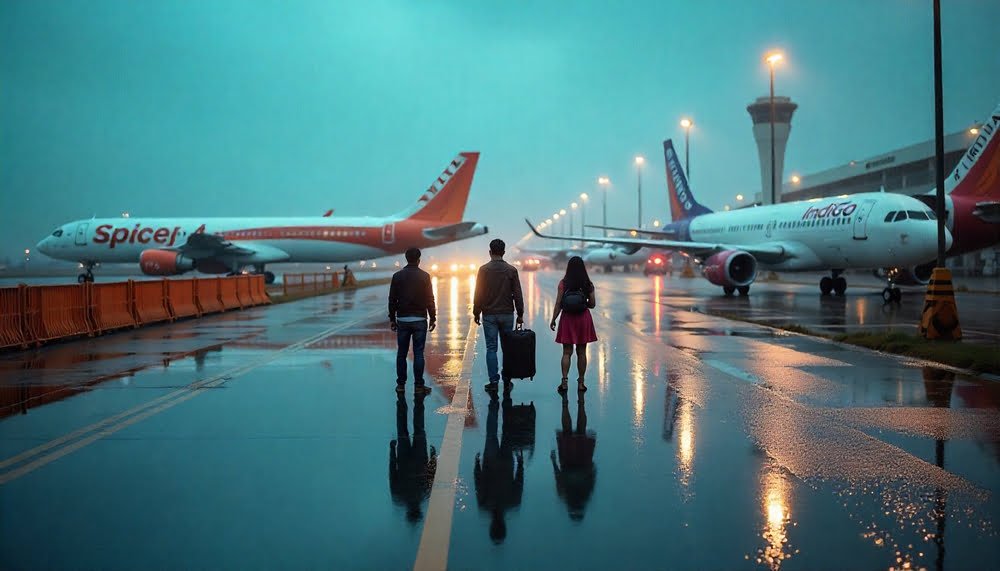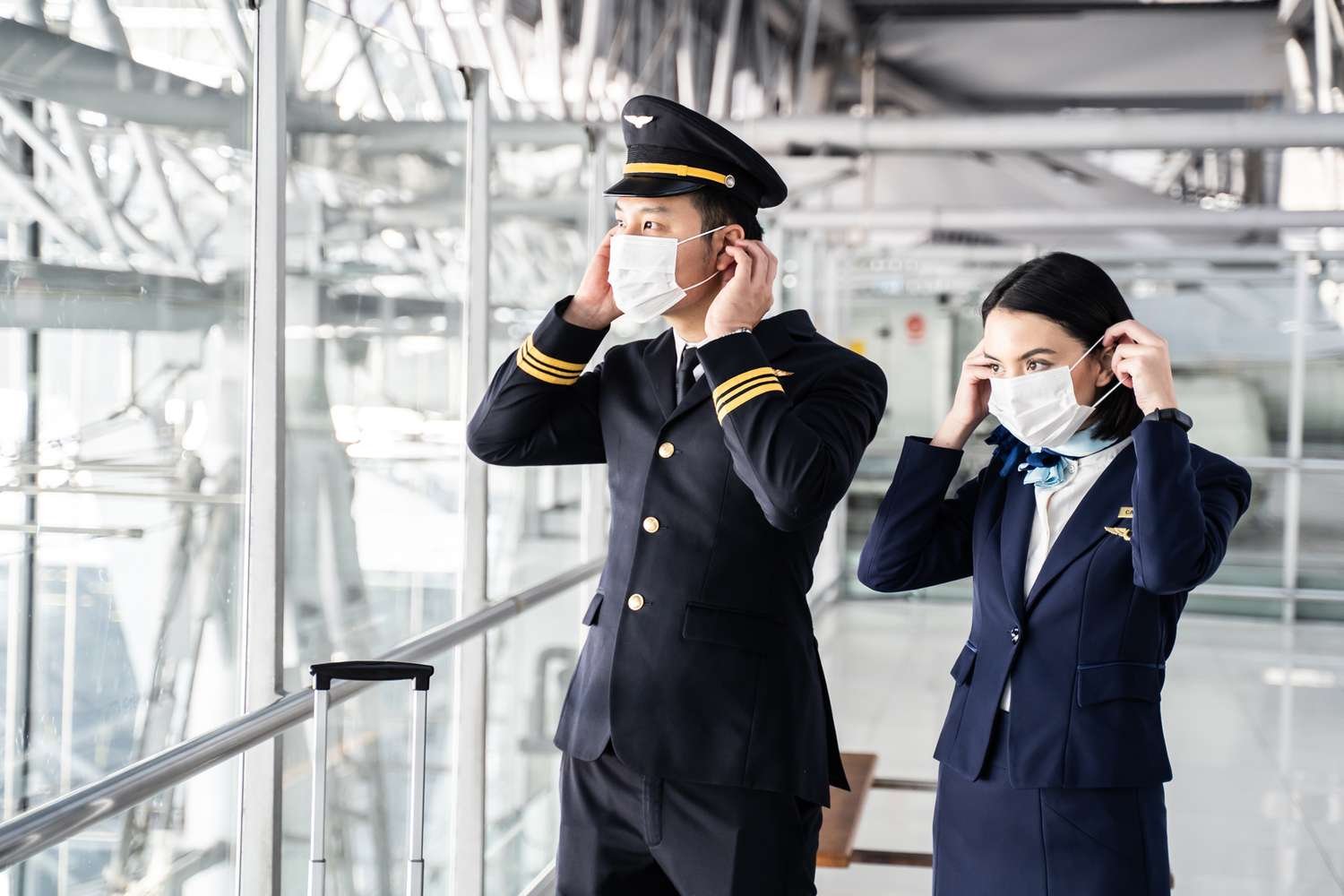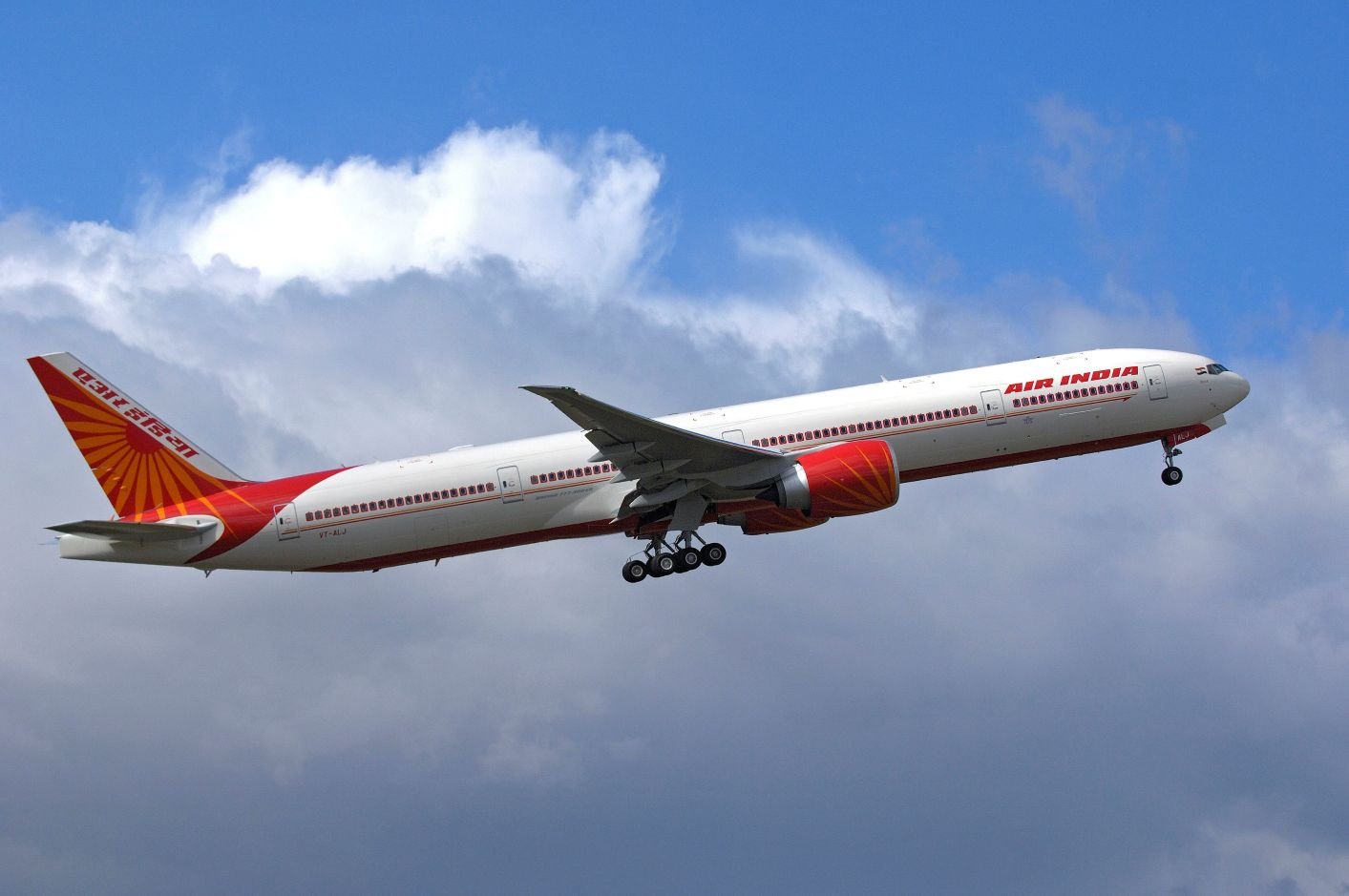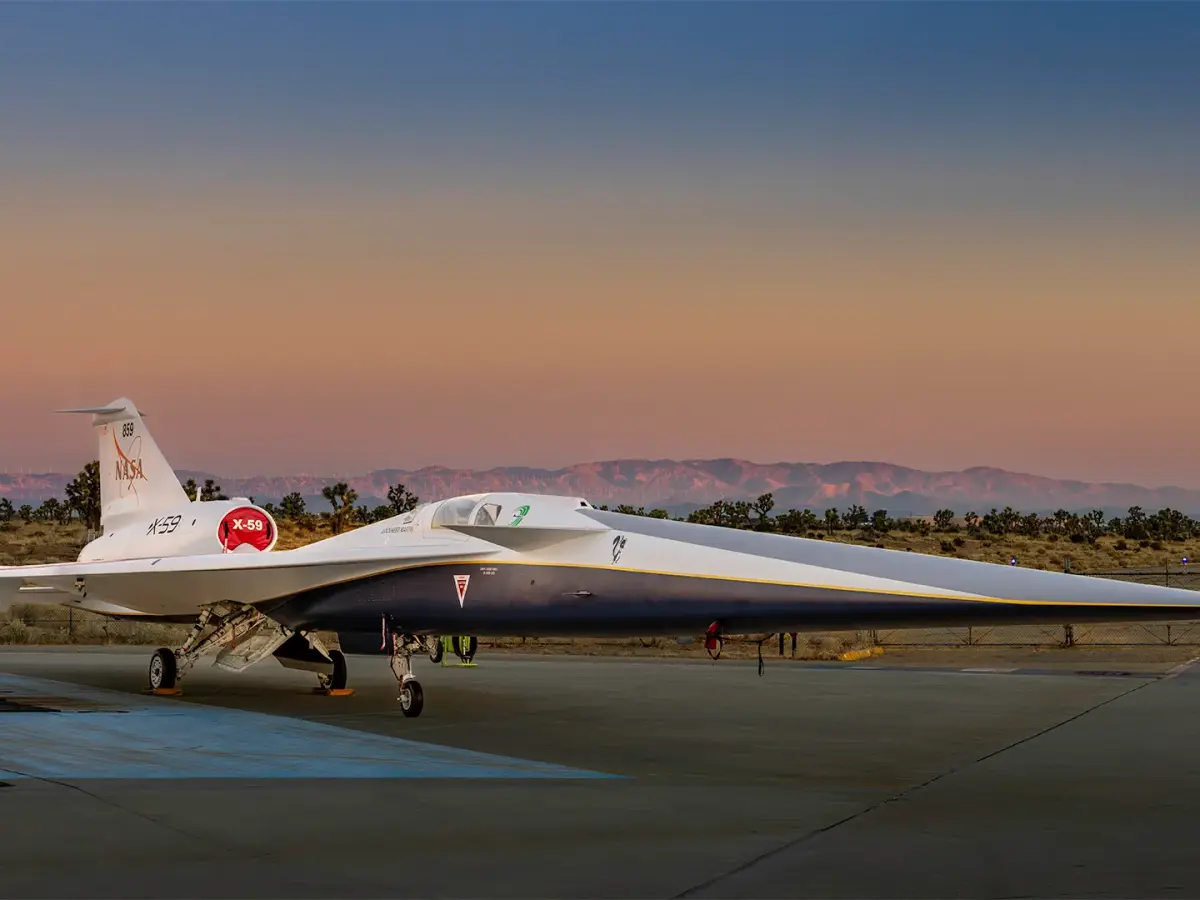Flight Buzz
Air India, IndiGo, and SpiceJet Issue Urgent Travel Alert Leaving Over 100 Flights Delayed in Delhi as Heavy Rain and Traffic Woes Leave Thousands of Travelers Stranded

Published on
August 9, 2025 |
August 9, 2025, brought chaos to travels at Delhi’s Indira Gandhi International Airport as Air India, IndiGo, and SpiceJet fired off urgent travel alerts. Heavy monsoon rain flooded the city, waterlogging critical routes and snarling the roads, leading to the late departure of more than 100 flights. The torrents on the tarmac matched those in the city, and the slow-moving traffic leaving downtown only compounded the problem, leaving thousands of passengers stuck at check-in counters and in taxi queues. With meteorologists expecting the rain to persist, the backlog grew, and passengers learned that the day’s travel plan—already strained—was only the start of a longer ordeal in the capital’s weather.
On the morning of August 9, 2025, heavy rainfall in Delhi led to significant disruptions across the city, resulting in over 100 flight delays at Indira Gandhi International Airport. Passengers traveling on major airlines such as Air India, IndiGo, and SpiceJet found themselves stranded as severe weather caused chaos in the skies and on the roads. The capital’s already congested roads became impassable, exacerbating the situation as travelers struggled to reach the airport amidst waterlogging and traffic gridlocks.
As the storm showed no signs of abating, airlines issued urgent travel advisories, urging passengers to plan their journeys in advance, check flight statuses regularly, and be prepared for extended waiting times.
Flight Delays and Disruptions at Indira Gandhi International Airport
Flight operations at Indira Gandhi International Airport were severely affected by the heavy rain. According to flight-tracking data from Flightradar24, more than 135 flights to and from the airport were delayed by early morning. Of these, 120 departing flights and 15 incoming flights were directly impacted, with delays ranging from 30 minutes to several hours.
The poor weather conditions, coupled with low visibility caused by the downpour, were the main reasons for the delays. Additionally, the waterlogged runways and flooded areas around the airport further complicated operations, preventing the timely departure and arrival of flights.
As a result, passengers faced long waits in terminals, many of them unsure of when they would be able to board their flights. The delays also had a ripple effect, extending throughout the day and affecting flights scheduled in the afternoon and evening.
Airlines Issue Travel Advisories Amid Disruptions
To mitigate the impact of the adverse weather, airlines such as Air India, IndiGo, and SpiceJet took proactive measures by issuing travel advisories to their passengers. The advisories were aimed at helping travelers navigate through the chaos and minimize their frustration.
- IndiGo, one of the largest low-cost carriers in India, advised its passengers to arrive at the airport well in advance to account for both weather-related delays and heavy traffic. The airline also recommended exploring alternate routes to the airport to avoid getting caught in traffic congestion.
- Air India echoed similar advice, urging passengers to check their flight statuses frequently and to allow extra time for their travel. They emphasized the importance of arriving early at the airport due to the slow-moving traffic caused by the rainfall.
- SpiceJet, which operates several domestic and international routes from Delhi, also issued warnings regarding possible delays. The airline advised passengers to remain patient and stay updated with real-time flight information, especially as the weather conditions continued to fluctuate.
These travel advisories were designed to help passengers manage their time more effectively and reduce the overall impact of the delays. However, despite these efforts, the ongoing weather conditions made it difficult to provide exact timelines for the resumption of normal flight operations.
The Impact of Severe Weather on Ground Transportation
In addition to the flight delays, the heavy rainfall caused major disruptions to ground transportation in Delhi. Several areas, including Mathura Road, Panchkuian Marg, and Connaught Place, were severely waterlogged, leading to massive traffic jams. Commuters trying to reach the airport were faced with slow-moving vehicles and increased travel times.
The traffic congestion was further exacerbated by the volume of vehicles trying to navigate through flooded streets, as well as the lack of clear drainage systems in some areas. As a result, many passengers missed their flights or were unable to reach the airport in time for check-in.
Local authorities worked to clear the roads, but the sheer volume of water on the streets made it challenging to restore normal conditions. As the storm persisted, the situation only worsened, with many roads remaining submerged under several inches of water for hours.
Public Transportation: A Viable Alternative
In light of the traffic chaos, Delhi Airport authorities recommended the use of public transportation, particularly the Delhi Metro, as a more efficient means of reaching the airport. The Delhi Metro, which connects various parts of the city to the airport, was suggested as an alternative to private vehicles, especially since the metro network was largely unaffected by the rain.
However, even the metro system saw some delays, although not to the extent of the road network. Passengers were advised to check the metro’s real-time updates to plan their journeys accordingly. Using the metro was particularly helpful for those who were trying to avoid the worst of the flooding on the roads.
Despite these suggestions, many travelers still faced long waits and uncertainties as they navigated through the disruptions caused by the severe weather.
Weather Forecast and Outlook
According to the India Meteorological Department (IMD), the heavy rain and thunderstorms that affected Delhi were expected to continue throughout the day. A red alert had been issued for the city, with further downpours anticipated in the afternoon and evening.
The IMD also predicted that these adverse weather conditions could extend into the next few days, which means travelers heading to Delhi may continue to face delays and disruptions over the weekend. The ongoing rain, coupled with the forecast of more storms, has left the city’s transportation systems vulnerable to further interruptions.
Authorities and airlines have stressed the importance of staying updated on the weather and flight statuses, as conditions could change rapidly throughout the day.
Advice for Passengers
Given the ongoing disruptions, travelers were advised to take the following precautions:
- Check Flight Status Frequently: With continuous changes in flight schedules, it is essential for passengers to check their flight statuses regularly via the airline’s website or app to stay informed about any delays or cancellations.
- Arrive Early: Due to slow-moving traffic and the possibility of further delays, passengers should arrive at the airport well in advance of their flight time. This will help account for any unforeseen circumstances and ensure they do not miss their flights.
- Consider Public Transportation: Whenever possible, passengers should use the Delhi Metro or other forms of public transport to avoid the traffic gridlocks caused by the heavy rain.
- Stay Patient and Prepared: Given the ongoing disruptions, it is important for travelers to remain patient and flexible with their plans. Flight delays are likely to continue, so passengers should be prepared for extended waiting times at the airport.
On August 9, 2025, heavy rainfall and severe traffic jams hit Delhi hard. The rainfall brought over 100 flight delays at Indira Gandhi International Airport, according to urgent alerts from Air India, IndiGo, and SpiceJet. Thousands of travelers were left waiting as waterlogged runways and flooded streets caused huge backups.
Rainfall worsened through the day. Passengers were told to check flight updates and keep plans flexible. The storms worsened not only air travel but ground transport too, keeping terminal roads and rail links choked with delays. Many missed onward connections, creating a ripple effect felt throughout the metro.
Air India, IndiGo, and SpiceJet tried to keep lines of communication open. They sent real-time updates and rescheduling links through apps and social media. Yet, with another storm system predicted to develop, travelers were urged to be patient and avoid arriving too early at the airport when roads were already clogged.
Delhi officials and airline teams continued to monitor weather radar and water levels. Plans included deploying extra buses and staff to ease the crush in the terminals. Passengers were reminded that with conditions still changing, the best approach was to keep checking flight info and allow extra time to get to their gate.
Flight Buzz
What Happens When a Pilot Gets Sick or Dies Mid-flight?

- Commercial airlines take precautions to keep passengers safe and avoid in-flight emergencies.
- Pilots must pass strict health checks and assess themselves before every flight to ensure they’re fit to fly.
- If a pilot gets sick mid-flight, the other pilot takes full control, and medical support can be coordinated remotely.
Commercial pilots may fly 900,000-pound jumbo jets with hundreds of passengers on board, but that doesn’t make them superhuman. Like us, they have immune systems that sometimes falter. While it’s uncommon for pilots to get sick or hurt on the job, it’s not unheard of. And rarely, they pass away mid-flight. Just last year, a Turkish Airlines flight from Seattle to Istanbul was forced to make an emergency landing in New York when its 59-year-old pilot collapsed and died a few hours into the 12-hour flight. Thankfully, these unfortunate incidents seldom lead to accidents or even situations that affect passengers—here’s what happens when a pilot gets sick mid-flight.
Preventative Measures
It’s important to note that most sick pilots never make it onto the flight in the first place. “This is because we assess our ‘Fitness to Fly’ prior to each flight,” explains Adam Cohen, a captain at SkyWest Airlines. While it’s not a comprehensive guide, the FAA’s pre-flight health checklist for pilots is called the IMSAFE Checklist. The letters stand for illness, medication, stress, alcohol, fatigue, and emotion. If a pilot doesn’t feel 100 percent in any category, or they’ve been impacted by medication or alcohol consumption, they should refrain from flying and notify their doctor.
Furthermore, in order to fly commercial planes carrying more than six passengers, all pilots need a medical certificate, issued by an official Aviation Medical Examiner. This certificate ensures they’re physically and mentally healthy, and it’s only good for 6-12 months, depending on the pilot’s age. Pilots must be seen by a doctor regularly, and they can’t be morbidly obese or have substance abuse issues.
What Happens If a Pilot Gets Sick Mid-flight
Despite the FAA and airlines’ best efforts to ensure commercial pilots are healthy—they even feed them different meals to prevent the entire flight deck from suffering from food poisoning—pilots occasionally fall ill during a flight they’re working. However, this doesn’t necessarily mean it’s a mayday situation. “If a pilot becomes sick or incapacitated in flight, the other pilot is fully qualified to take over and safely operate the aircraft,” explains Rock Saddy, a pilot and liaison for Cirrus Aviation Services. “Commercial flights always have at least two trained pilots on the flight deck, and in some cases, particularly long-haul routes, a relief pilot may also be on board.”
In addition to keeping passengers comfortable, flight attendants are trained to assist in medical emergencies. And according to the Centers for Disease Control and Prevention (CDC), U.S. aircrafts with one or more flight attendants on board are required to have a U.S. Food and Drug Administration-approved automated external defibrillator on board as well as a first aid kit, plus an emergency medical kit containing certain medications you wouldn’t find in a first aid kit.
Saddy tells Travel + Leisure that many airlines also have 24/7 access to services such as MedLink that connect flight crews with emergency room doctors via phone, satellite, or radio. If the pilot is seriously ill, the trained doctor will instruct the pilot taking over to divert to the nearest appropriate airport so the sick pilot can receive medical attention.
Passenger Volunteers
Most frequent fliers can recall a time when they were on a flight and the crew asked passengers who were doctors or nurses to volunteer to assist in the event of a medical emergency. Because this happens rather frequently (although it’s most often a fellow passenger, not the pilot, who needs help), the Aviation Medical Assistance Act, which passed in 1998, includes a section that protects medical personnel from being sued for providing “good-faith” medical care in the event of an emergency.
However, this only applies to domestic flights within the U.S. It may not cover you on an international flight. And if you’ve been consuming alcohol, you could be liable for misconduct or negligence. Ultimately, whether or not you step forward to assist is up to you, so read up on the regulations before you travel.
Flight Buzz
UAE-India Flights: ‘Freedom Sale’ Fares from DH53 for UAE Destinations

Published on
August 10, 2025 |
Air India Express has announced a major discount on flights as part of its “Freedom Sale” to celebrate India’s 79th Independence Day. The sale offers domestic and international tickets starting at just Rs 1,279 (Dh53.50) for domestic flights and Rs 4,279 (Dh179) for international routes, making travel between India and the UAE more affordable for millions of passengers. This promotion is expected to benefit a significant number of travelers, especially those between the UAE and India, two countries with strong tourism and diaspora connections.
The airline is offering a total of five million discounted seats across its domestic and international network, which includes routes connecting Dubai, Abu Dhabi, Sharjah, and Ras Al Khaimah with major cities in India. With more than 3.7 million Indian nationals residing in the UAE, alongside tourists visiting both countries, the sale is expected to boost tourism and make travel more accessible, especially during peak seasons like Onam, Durga Puja, Deepawali, and Christmas.
Boosting Tourism across UAE-India with Affordable Airfare
The new sale will help drive tourism between India and the UAE, strengthening the tourism sector by offering more budget-friendly travel options. Many tourists traveling for holidays, festivals, and business visits will be able to take advantage of the affordable fares, thus promoting cultural exchange and facilitating visits for families separated by long distances. This could lead to an increase in bookings for Indian nationals visiting friends and relatives, as well as foreign tourists traveling to India or the UAE for leisure or business.
The discounted fares are particularly beneficial for the Indian diaspora in the UAE, as well as the millions of tourists who travel between the two countries. The ease of affordable travel is likely to encourage more people to take vacations or visit family during the upcoming festive season. The sale aligns with the growing trend of making travel more accessible for middle-class families and business professionals.
Key Sale Details and Travel Period
The “Freedom Sale” opened exclusively on Air India Express’ official website and app on Sunday, August 10, 2025, and will remain available on all major booking channels until Friday, August 15, 2025. The discounted travel period spans from August 19, 2025, to March 31, 2026, ensuring that travelers can make the most of this offer during key holiday periods. This includes popular festivals such as Onam, Durga Puja, Deepawali, Christmas, and New Year, making it an ideal time for both leisure and family travel.
With a fleet of 116 aircraft, Air India Express operates over five hundred daily flights to thirty-eight domestic and seventeen international destinations. The airline’s extensive network of destinations ensures that passengers from various parts of India and the UAE can access affordable flights to travel back and forth between the two countries.
Special Offers for Students, Senior Citizens, and Armed Forces Personnel
In addition to the regular discounts, Air India Express is offering special fares and benefits for students, senior citizens, armed forces personnel, and their dependents. These groups, who often face travel restrictions due to higher costs, can benefit from additional savings in flight bookings, which could help boost travel among these communities. By offering these special fares, the airline is promoting greater inclusivity in tourism, ensuring that people from different walks of life can enjoy affordable air travel between India and the UAE.
Expected Impact on UAE-India Tourism
This special fare offer from Air India Express is expected to have a substantial impact on tourism. The UAE and India are major tourism hubs, with people frequently traveling between the two countries for business, cultural exchanges, and tourism. With such a large proportion of Indian nationals residing in the UAE, the ease of affordable travel will likely lead to more frequent visits for holidays and family gatherings.
Furthermore, the ongoing promotion could encourage more UAE residents to visit India, boosting inbound tourism to popular destinations such as Delhi, Mumbai, Jaipur, and Kerala. The discounted fares are expected to create a ripple effect in the local tourism industry, as more visitors from the UAE arrive in India, potentially leading to increased demand for hotels, tour packages, and local attractions.
A Win for Travelers and the Tourism Sectors
Air India Express’ “Freedom Sale” offers an excellent opportunity for travelers to take advantage of discounted fares, boosting tourism and increasing access to both domestic and international destinations. With the added benefit of special fares for students, senior citizens, and armed forces personnel, this sale is set to provide an affordable and convenient travel experience for many, further fostering cultural and tourism exchanges between the UAE and India.
Image Credit: Air India
Flight Buzz
NASA’s X-59 is helping revive supersonic passenger flights! Here’s how

If companies meet these targets, the US could see a new golden age of high-speed aviation, reshaping business travel, tourism, and even the economics of flight routes. While environmental and cost challenges remain, the return of supersonic flight is no longer science fiction, it’s a matter of a few years.
-

 Brand Stories3 weeks ago
Brand Stories3 weeks agoBloom Hotels: A Modern Vision of Hospitality Redefining Travel
-

 Brand Stories2 weeks ago
Brand Stories2 weeks agoCheQin.ai sets a new standard for hotel booking with its AI capabilities: empowering travellers to bargain, choose the best, and book with clarity.
-

 Destinations & Things To Do3 weeks ago
Destinations & Things To Do3 weeks agoUntouched Destinations: Stunning Hidden Gems You Must Visit
-

 Destinations & Things To Do2 weeks ago
Destinations & Things To Do2 weeks agoThis Hidden Beach in India Glows at Night-But Only in One Secret Season
-

 AI in Travel3 weeks ago
AI in Travel3 weeks agoAI Travel Revolution: Must-Have Guide to the Best Experience
-

 Brand Stories1 month ago
Brand Stories1 month agoVoice AI Startup ElevenLabs Plans to Add Hubs Around the World
-

 Brand Stories4 weeks ago
Brand Stories4 weeks agoHow Elon Musk’s rogue Grok chatbot became a cautionary AI tale
-

 Brand Stories2 weeks ago
Brand Stories2 weeks agoContactless Hospitality: Why Remote Management Technology Is Key to Seamless Guest Experiences
-

 Asia Travel Pulse1 month ago
Asia Travel Pulse1 month agoLooking For Adventure In Asia? Here Are 7 Epic Destinations You Need To Experience At Least Once – Zee News
-

 AI in Travel1 month ago
AI in Travel1 month ago‘Will AI take my job?’ A trip to a Beijing fortune-telling bar to see what lies ahead | China













You must be logged in to post a comment Login